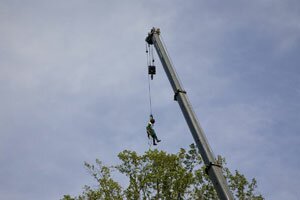PHOTOPHILE- Poplar mechanics: Bartlett's familiar Monticello amputation

Ryan Wilkins of Bartlett Tree Experts is lifted into the tree to begin work.
PHOTO BY RYAN HOOVER
It's a classic tale of a tree whose days in the sun had come to an end. For Monticello officials, the felling of a 115-foot-tall tulip poplar on the West lawn was the sad yet necessary ending to a very long life.
How long? They're not sure, as most of the trunk's growth rings were destroyed by an invading root disease called Phytophthora.
The Thomas Jefferson Foundation aims to maintain the house and grounds– a World Heritage Site– as close to Jefferson's functional and aesthetic intent as possible. The placement and age of the tree made it both a blessing and a curse beside such a historic structure.
Professional arborists had long warned that the tree's rotting frame could one day fall and damage the cherished landmark.
"The county was divided into removers and preservers," says Maryland-based aboriculturist Donald Blair, who worked with late Charlottesville mayor/arborist Mitch Van Yahres to find creative ways to keep the tree structurally intact.
"The care that Monticello gave this tree allowed it to remain standing until it aged naturally," Blair says. "There were people who wanted to rip it down, but it got a reprieve."
The tree has been so firmly rooted into the image of Monticello that until 1976, the image of the house gracing the back of the American $2 bill included a tree in that spot. Jefferson wrote in his garden book that he planted a tulip poplar there in 1807. Is this the one?
The Garden Club of Virginia, investigating in the 1930s, thought so. However, the late George Van Yahres, father of Mitch, disagreed.
As the tree ranged through sickness and health throughout its lifetime, the Van Yahres Tree Company– and later, Blair– created various cabling systems to keep it standing. In 1927, George Van Yahres pruned the top of the diseased tree into four "fingers" to create what is today the tree's canopy, while in 1978, Mitch Van Yahres cabled the tree to two other trees on the West Lawn.
When concerns about the tree's stability resurfaced in 1997, Blair constructed an internal cabling system to hold the four fingers together.
Whether the tree was planted by Jefferson, it has seen much of Monticello's history. That came to a rip-roaring end June 25 and 26 when it was felled by crews from Bartlett Tree Experts.
According to Peter Hatch, Monticello's director of gardens and grounds, the Foundation is not yet sure if it will use the tree's remains to create mementoes for sale. Plans to plant a new tulip poplar in its place are also uncertain. Nevertheless, the impact of the aesthetic loss will be felt by Monticello's visitors and those who make the visits possible.
"It's gonna be a sad thing, it's such a beautiful tree," Robert Johnson, a Monticello grounds worker of 31 years, says. "There's gonna be an open space, and it'll take a while to get used to not seeing it there."

The tulip poplar will leave a gap on Monticello's West Lawn.

As the only house in America named a World Heritage Site, Monticello's main structure would be compromised if the tree were to fall.

Peter Hatch, the Thomas Jefferson Foundation's director of gardens and grounds

The Thomas Jefferson Foundation might create mementoes from the tree's remains. A felled beech in the '50s yielded gavels for the Democratic National Convention.

The poplar, relieved of its canopy, awaits its fate on June 26.
#
2 comments
I have been following the story of this tree. Thanks for the good background information and sharing the neat pictures!
God has cared for these trees, saved them from drought, disease, avalanches, and a thousand tempests and floods. But he cannot save them from fools. - John Muir